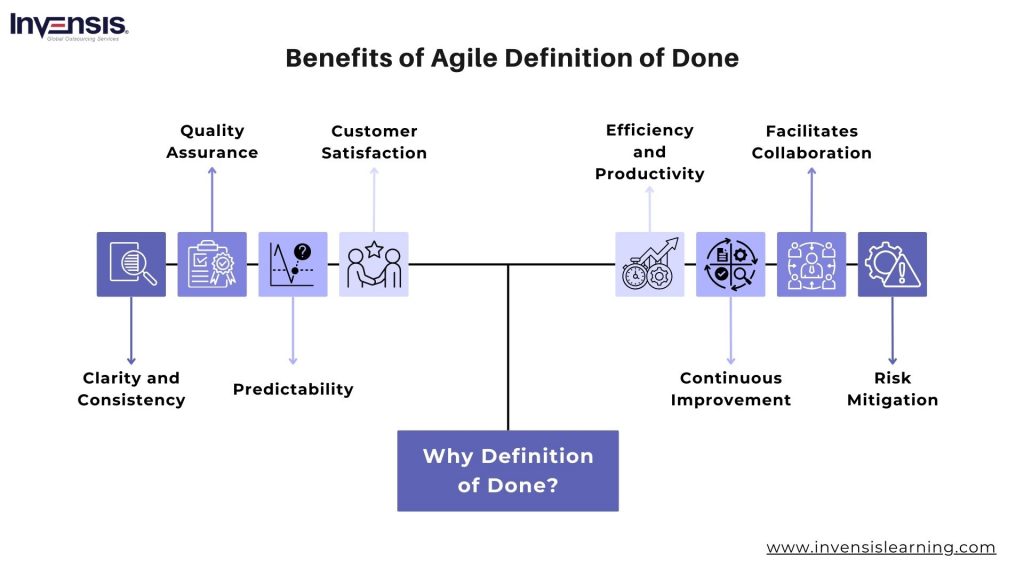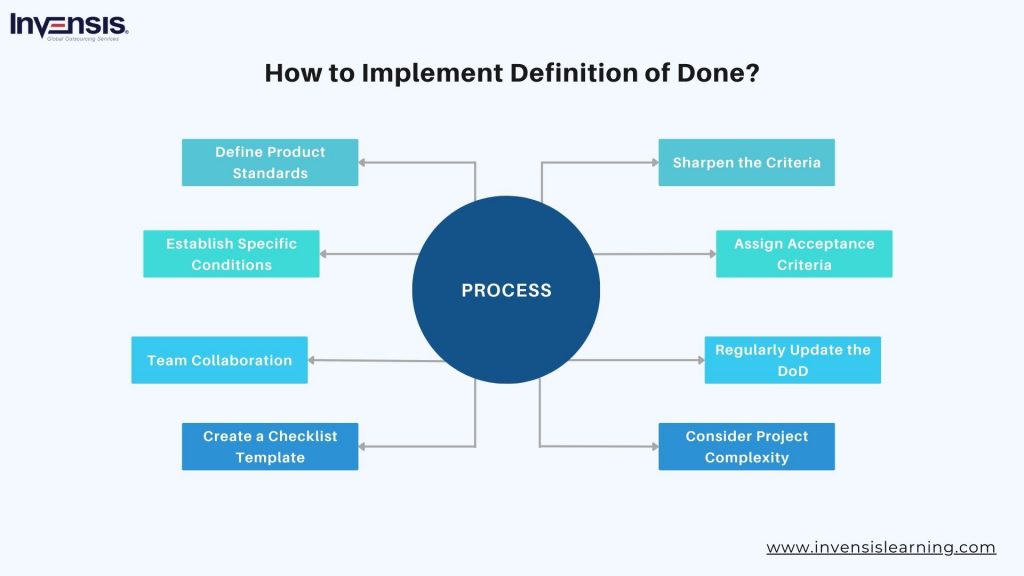
Have you ever wondered what exactly constitutes the “Definition of Done” in Agile methodologies?
Agile practices have become increasingly popular for their iterative and collaborative approach in today’s Agile world of software development. The concept of the Definition of Done serves as a key element in Agile frameworks, outlining the criteria that must be met for a user story or task to be considered finished.
In this blog we’ll delve into the intricacies of the Definition of Done, exploring its significance, components, and how it contributes to the overall success of Agile teams. Gain insights into achieving project completion with precision and efficiency.
Table of Contents:
- What is the Definition of Done in Agile?
- Benefits of Agile Definition of Done
- Criteria of Definition of Done
- How to Implement Definition of Done?
- Conclusion
What is the Definition of Done in Agile?
The “Definition of Done” (DoD) in Agile is a set of criteria or conditions that must be met for a user story, feature, or task to be considered complete. It serves as a shared understanding among the Agile team members about what it means for work to be finished and ready for delivery.
The DoD encompasses various aspects, including coding standards, testing requirements, documentation, and any other criteria relevant to the team’s definition of completeness.
The Definition of Done acts as a quality checklist, ensuring that the team consistently produces work that meets certain standards. This concept is vital in Agile methodologies because it helps maintain transparency, manage expectations, and facilitate effective collaboration among team members.
A well-defined Definition of Done contributes to delivering high-quality, shippable increments at the end of each iteration, aligning with Agile principles of continuous delivery and customer satisfaction.
Benefits of Agile Definition of Done
Discover the benefits of Agile Definition of Done From ensuring clarity and consistency to streamlining development for efficiency. This critical concept enhances collaboration, customer satisfaction, and overall project success.
-
Clarity and Consistency
Establishing a clear and consistent set of criteria for completion ensures that all team members share a common understanding of what “done” means. This clarity reduces and fosters a shared commitment to quality.
-
Quality Assurance
The DoD acts as a quality assurance mechanism, setting standards for coding, testing, and other aspects of development. This helps prevent the introduction of defects and ensures that each increment meets the desired level of quality.
-
Predictability
With a well-defined DoD, teams can predict the time required to complete tasks more accurately. This enhances overall project predictability and enables stakeholders to have realistic expectations about when features will be delivered.
-
Customer Satisfaction using Definition of Done Concept
The DoD aligns development efforts with customer expectations. By consistently delivering increments that meet the established criteria, teams enhance customer satisfaction and build trust in the development process.
-
Efficiency and Productivity
Having a clear Definition of Done streamlines the development process. Team members can focus on completing work efficiently without uncertainty about the necessary steps for completion.
-
Continuous Improvement
The DoD serves as a baseline for continuous improvement. Teams can regularly review and update the definition, adapting it based on feedback and lessons learned, which contributes to ongoing improvements in development practices.
-
Facilitates Collaboration
The DoD promotes collaboration among team members, including developers, testers, and product owners. It encourages open communication and ensures that everyone is working towards the same goal of delivering high-quality, completed work.
-
Risk Mitigation
By clearly defining the criteria for completion, the DoD helps mitigate risks associated with incomplete or substandard work. Teams can catch issues early in the development process, reducing the likelihood of problems emerging later in the project.
Enroll in Invensis Learning’s top Agile Certification courses and master the concept of DoD!
Criteria of Definition of Done
Definition of Done (DoD) provides concrete illustrations of the criteria and standards teams set for completing tasks in Agile development. Here are a few examples
- Code Review and Approval: Code must undergo a thorough review process, and any identified issues must be addressed before considering the task done.
- Unit Testing: All code changes must pass unit tests to ensure that individual components function correctly and meet specified requirements.
- Integration Testing: After unit testing, code changes should be integrated and tested to verify that they work seamlessly.
- Documentation: Complete and accurate documentation, including user manuals or technical documentation, must accompany the code to facilitate understanding and future maintenance.
- User Acceptance Testing (UAT): Before declaring a task done, it may need to pass user acceptance testing to ensure it meets the end user’s expectations and requirements.
- Performance Testing: Tasks may need to undergo performance testing to meet predefined performance benchmarks and not degrade system performance.
- Deployment: Code changes should be ready for deployment to the production environment, with any necessary configurations and dependencies addressed.
- Product Owner Approval: The Product Owner must review and approve the completed task to ensure it aligns with the overall product vision and meets business objectives.
- Defect Resolution: Any identified defects or issues must be resolved, and the task retested to confirm that the corrections are effective.
- Feedback Incorporation: Teams may define that user feedback is incorporated into the task before considering it done, ensuring a customer-centric approach.
How to Implement Definition of Done?
Creating an effective Definition of Done (DoD) involves a thoughtful and collaborative process within the Agile team. Here’s a step-by-step guide based on the provided content.
-
Define Product Standards
Begin by understanding existing production standards in your organization and using them as a starting point. If none exist or are not applicable, answer key questions about product usage, working environments, required tests, and necessary documentation.
-
Establish Specific Conditions
Define precise conditions, such as the specific tests to be performed, their types, and the desired testing outcomes. Determine what it means for the work of individual team members to be integrated into the final product, adhering to common terminology.
-
Team Collaboration
Decide on the Definition of Done collaboratively as a team, ensuring the criteria are realistic and achievable. Exclude elements that are difficult or impractical to follow. The aim is to have criteria that provide internal confidence that the finished work meets requirements.
-
Create a Checklist Template
Develop a checklist template as part of the DoD. This template serves as a criterion to be met before considering a task or issue complete. Embed the DoD into the workflow to ensure it applies consistently to every sprint task.
-
Sharpen the Criteria
Ensure that the criteria are clear and well-defined, avoiding vague statements. Common elements include manual and automated testing, unit tests, updated documentation, and preparation of implementation manuals or scripts.
-
Assign Acceptance Criteria
Assign acceptance criteria to each individual task to ensure clarity and attention. This ensures that every issue includes relevant information for the team to understand what needs to be accomplished during development.
-
Regularly Update the Definition of Done (DoD)
Recognize that the Definition of Done evolves with the product. Regularly inspect and adapt the DoD, incorporating new criteria and making existing ones more stringent. The Sprint Retrospective is an opportune time to update the DoD for the upcoming sprint.
-
Consider Project Complexity
In a large project with different application layers and teams, acknowledge the complexity of creating a universal DoD. Use common sense, introduce a common list of completion criteria where possible, and allow teams to have additional acceptance criteria tailored to their specific responsibilities.
Conclusion
The Definition of Done (DoD) in Agile serves as a cornerstone, providing a shared understanding of completion criteria within the team. Its significance extends across the development process, fostering clarity, consistency, and a commitment to delivering high-quality increments. The DoD’s benefits encompass improved quality assurance, predictability, customer satisfaction, and efficiency.
DoD cultivates a culture of continuous improvement, adapting to the evolving needs of Agile teams. Through meticulous implementation and refinement, the DoD ensures transparent collaboration, mitigates risks, and consistently empowers teams to deliver valuable software increments that align with customer expectations.
Discover excellence through our “Agile Certification Courses” courses at Invensis. Learn the essential completion criteria for success in Agile methodologies, boosting your team’s performance in innovation, collaboration, and customer satisfaction. Enhance your skills to achieve completeness in every sprint.
















